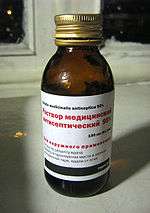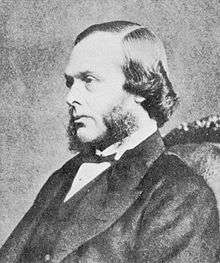Antiseptic
Antiseptics (from Greek ἀντί anti, "against"[1] and σηπτικός sēptikos, "putrefactive"[2]) are antimicrobial substances that are applied to living tissue/skin to reduce the possibility of infection, sepsis, or putrefaction. Antiseptics are generally distinguished from antibiotics by the latter's ability to safely destroy bacteria within the body, and from disinfectants, which destroy microorganisms found on non-living objects.[3]
Some antiseptics are true germicides, capable of destroying microbes (bacteriocidal), while others are bacteriostatic and only prevent or inhibit their growth.[4]
Antibacterials include antiseptics that have the proven ability to act against bacteria. Microbicides which destroy virus particles are called viricides or antivirals. Antifungals, also known as an antimycotics, are pharmaceutical fungicides used to treat and prevent mycosis (fungal infection).
Surgery
The widespread introduction of antiseptic surgical methods was initiated by the publishing of the paper Antiseptic Principle of the Practice of Surgery in 1867 by Joseph Lister, which was inspired by Louis Pasteur's germ theory of putrefaction.[5] In this paper, Lister advocated the use of carbolic acid (phenol) as a method of ensuring that any germs present were killed. Some of this work was anticipated by:
- Ancient Greek physicians Galen (circa 130–200) and Hippocrates (circa 400 BC) and Sumerian clay tablets dating from 2150 BC that advocate the use of similar techniques.[6]
- Medieval surgeons Hugh of Lucca, Theoderic of Servia, and his pupil Henri de Mondeville were opponents of Galen's opinion that pus was important to healing, which had led ancient and medieval surgeons to let pus remain in wounds. They advocated draining and cleaning the wound edges with wine, dressing the wound after suturing, if necessary and leaving the dressing on for ten days, soaking it in warm wine all the while, before changing it. Their theories were bitterly opposed by Galenist Guy de Chauliac and others trained in the classical tradition.[7]
- Oliver Wendell Holmes, Sr., who published The Contagiousness of Puerperal Fever in 1843
- Florence Nightingale, who contributed substantially to the report of the Royal Commission on the Health of the Army (1856–1857), based on her earlier work
- Ignaz Semmelweis, who published his work The Cause, Concept and Prophylaxis of Childbed Fever in 1861, summarizing experiments and observations since 1847[8]]
Some common antiseptics

- Alcohols, including ethanol and 2-propanol/isopropanol are sometimes referred to as surgical spirit. They are used to disinfect the skin before injections are given, among other uses.
- Chlorhexidine gluconate is used as a skin antiseptic and to treat inflammation of the gums (gingivitis).
- Chloroxylenol is an antiseptic and disinfectant which is used for skin disinfection and cleaning surgical instruments. It is also used within a number of household disinfectants and wound cleaners.
- Hydrogen peroxide is used as a 6% (20 Vols) solution to clean and deodorize wounds and ulcers. More commonly, 3% solutions of hydrogen peroxide have been used in household first aid for scrapes, etc. However, the strong oxidization causes scar formation and increases healing time during fetal development.[9]
- Iodine is usually used in an alcohol solution (called tincture of iodine) or as Lugol's iodine solution as a pre- and postoperative antiseptic. Some studies [10] do not recommend disinfecting minor wounds with iodine because of concern that it may induce scar tissue formation and increase healing time. However, concentrations of 1% iodine or less have not been shown to increase healing time and are not otherwise distinguishable from treatment with saline.[11] Novel iodine antiseptics containing povidone-iodine (an iodophor, complex of povidone, a water-soluble polymer, with triiodide anions I3−, containing about 10% of active iodine) are far better tolerated, do not negatively affect wound healing, and leave a deposit of active iodine, thereby creating the so-called "remnant", or persistent, effect. The great advantage of iodine antiseptics is their wide scope of antimicrobial activity, killing all principal pathogens and, given enough time, even spores, which are considered to be the most difficult form of microorganisms to be inactivated by disinfectants and antiseptics.
- Octenidine dihydrochloride, currently increasingly used in continental Europe, often as a chlorhexidine substitute.
- Polyhexanide (polyhexamethylene biguanide, PHMB) is an antimicrobial compound suitable for clinical use in critically colonized or infected acute and chronic wounds. The physicochemical action on the bacterial envelope prevents or impedes the development of resistant bacterial strains.[12][13][14]
- Balsam of Peru is a mild antiseptic.[15][16][17]
- Dakin's solution is a sodium hypochlorite solution, originally also containing boric acid to lower pH. It is mostly used on live tissues for cleaning wounds of bacteria, fungi and viruses. Because of practicality of preparation and lower cost, it is largely used in Veterinary Medicine[18] treatments. It is colourless and does not stain the animal's fur or affect its aesthetic or commercial value.
- Super-oxidized solutions (SOS) contain hypochlorous acid (HClO) (<0.005%) and are stabilised at a neutral pH. SOS are rapidly acting (30s-5m),[19] broad spectrum antiseptics that are clinically effective at non-cytotoxic concentrations that in contrast to many cytotoxic antiseptics, support wound healing.[20] There is now growing consensus that modern SOS are more effective for healing wounds faster.[21]
Evolved resistance
After continued exposure to antibiotics, bacteria may evolve to the point where they are no longer harmed by these compounds. Bacteria can also develop a resistance to antiseptics, but the effect is generally less pronounced.[22][23]
The mechanisms by which bacteria evolve may vary in response to different antiseptics. Low concentrations of an antiseptic may encourage growth of a bacterial strain that is resistant to the antiseptic, where a higher concentration of the antiseptic would simply kill the bacteria. In addition, use of an excessively high concentration of an antiseptic may cause tissue damage or slow the process of wound healing.[11] Consequently, antiseptics are most effective when used at the correct concentration—a high enough concentration to kill harmful bacteria, fungi or viruses, but a low enough concentration to avoid damage to the tissue.
See also
- Henry Jacques Garrigues, introduced antiseptic obstetrics to North America
- Joseph Lister
- Louis Pasteur
- Ignaz Semmelweis
Notes
- Liddell, Henry George; Scott, Robert. "ἀντί". A Greek-English Lexicon. Perseus perseus.tufts.edu. Archived from the original on 10 October 2012.
- Liddell, Henry George; Scott, Robert. "σηπτικός". A Greek-English Lexicon. Perseus perseus.tufts.edu. Archived from the original on 10 October 2012.
- McDonnell, Gerald; Russell, A. Denver (January 1999). "Antiseptics and Disinfectants: Activity, Action, and Resistance". Clinical Microbiology Reviews. 12 (1): 147–79. doi:10.1128/CMR.12.1.147. PMC 88911. PMID 9880479.
-

- Chisholm 1911.
- Eming SA, Krieg T, Davidson JM (2007). "Inflammation in wound repair: molecular and cellular mechanisms". J. Invest. Dermatol. 127 (3): 514–25. doi:10.1038/sj.jid.5700701. PMID 17299434.
- Edwards H (1976). "Theodoric of Cervia, a medieval antiseptic surgeon". Proceedings of the Royal Society. 69 (3): 553–5. PMC 1864551. PMID 790395.
- Best M, Neuhauser D (2004). "Ignaz Semmelweis and the birth of infection control". Qual Saf Health Care. 13 (3): 233–4. doi:10.1136/qhc.13.3.233. PMC 1743827. PMID 15175497.
- Wilgus TA, Bergdall VK, Dipietro LA, Oberyszyn TM (2005). "Hydrogen peroxide disrupts scarless fetal wound repair". Wound Repair Regen. 13 (5): 513–9. doi:10.1111/j.1067-1927.2005.00072.x. PMID 16176460.
- Vermeulen, H.; Westerbos, S.J.; Ubbink, D.T. (2010). "Benefit and harm of iodine in wound care: a systematic review". Journal of Hospital Infection. 76 (3): 191–199. doi:10.1016/j.jhin.2010.04.026. ISSN 0195-6701. PMID 20619933.
- "Antiseptics on Wounds: An Area of Controversy: Hydrogen Peroxide". Medscape.com. Archived from the original on 19 July 2013. Retrieved 4 March 2014.
- Kaehn K (2010). "Polihexanide: a safe and highly effective biocide". Skin Pharmacol Physiol. 23 Suppl: 7–16. doi:10.1159/000318237. PMID 20829657. S2CID 684665.
- Eberlein T, Assadian O (2010). "Clinical use of polihexanide on acute and chronic wounds for antisepsis and decontamination". Skin Pharmacol Physiol. 23 Suppl: 45–51. doi:10.1159/000318267. PMID 20829662.
- Eberlein T, Haemmerle G, Signer M, et al. (January 2012). "Comparison of PHMB-containing dressing and silver dressings in patients with critically colonised or locally infected wounds". J Wound Care. 21 (1): 12, 14–6, 18–20. doi:10.12968/jowc.2012.21.1.12. PMID 22240928. Archived from the original on 18 June 2013.
- Attfield, John (1906). Chemistry: general, medical, and pharmaceutical — Google Books. p. 460. Archived from the original on 29 April 2016. Retrieved 15 March 2016.
- Khan, Ikhlas A.; Abourashed, Ehab A. (21 September 2011). Leung's Encyclopedia of Common Natural Ingredients: Used in Food, Drugs and ... - Ikhlas A. Khan, Ehab A. Abourashed — Google Books. p. 41. ISBN 9781118213063. Archived from the original on 16 April 2016. Retrieved 15 March 2016.
- Schmalz, Gottfried; Bindslev, Dorthe Arenholt (10 October 2008). Biocompatibility of Dental Materials — Gottfried Schmalz, Dorthe Arenholt Bindslev — Google Books. p. 352. ISBN 9783540777823. Archived from the original on 12 April 2016. Retrieved 15 March 2016.
- "Unique Therapies for Difficult Wounds - Today's Veterinary Practice". todaysveterinarypractice.navc.com. July 2011. Archived from the original on 19 March 2018. Retrieved 28 April 2018.
- Landa-Solis, C.; González-Espinosa, D.; Guzmán-Soriano, B.; Snyder, M.; Reyes-Terán, G.; Torres, K.; Gutierrez, A.A. (December 2005). "Microcyntm: a novel super-oxidized water with neutral pH and disinfectant activity". Journal of Hospital Infection. 61 (4): 291–299. doi:10.1016/j.jhin.2005.04.021. ISSN 0195-6701. PMID 16242210.
- Kramer, Axel; Dissemond, Joachim; Kim, Simon; Willy, Christian; Mayer, Dieter; Papke, Roald; Tuchmann, Felix; Assadian, Ojan (21 December 2017). "Consensus on Wound Antisepsis: Update 2018". Skin Pharmacology and Physiology. 31 (1): 28–58. doi:10.1159/000481545. ISSN 1660-5527. PMID 29262416. S2CID 3601026.
- Kramer, Axel; Dissemond, Joachim; Kim, Simon; Willy, Christian; Mayer, Dieter; Papke, Roald; Tuchmann, Felix; Assadian, Ojan (21 December 2017). "Consensus on Wound Antisepsis: Update 2018". Skin Pharmacology and Physiology. 31 (1): 28–58. doi:10.1159/000481545. ISSN 1660-5527. PMID 29262416. S2CID 3601026.
- Levy, Stuart B. (2001). "Antibacterial Household Products: Cause for Concern". Emerging Infectious Diseases. 7 (3 Suppl): 512–515. doi:10.3201/eid0707.017705. PMC 2631814. PMID 11485643.
- Albina Mikhaylova; Bernd Liesenfeld; William Toreki; David Moore; Jillian Vella; Roy Carr; Gerald Olderman; Christopher Batich; Gregory Schultz (2009). "Bacterial Resistance Issues in Wound Care and Wound Dressings" (PDF). QuickMedTechnologies. Symposium on Advanced Wound Care and Wound Healing Society Meeting, Poster LB-051. Archived (PDF) from the original on 3 March 2016. Retrieved 4 March 2014.
External links
- . New International Encyclopedia. 1905.
